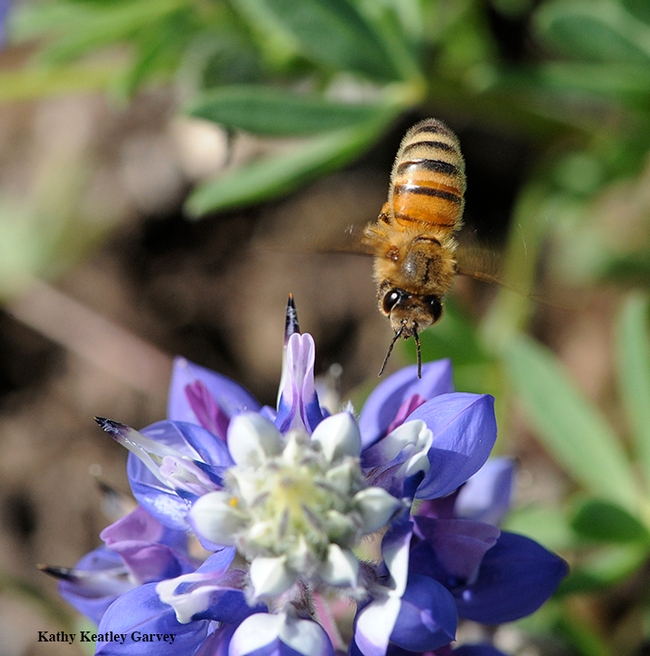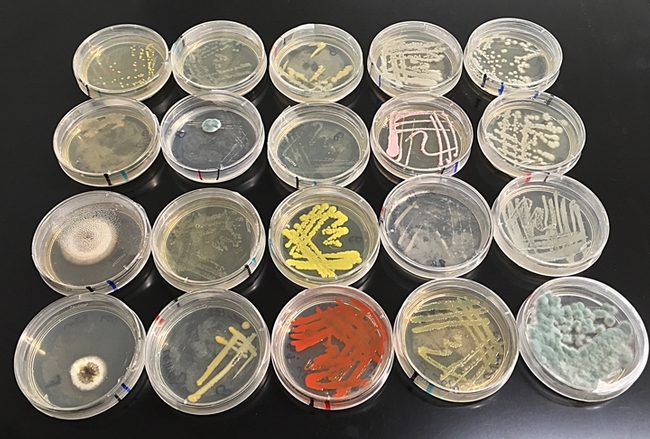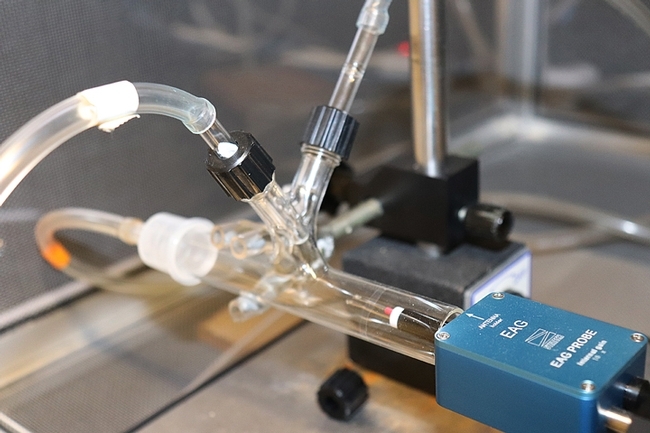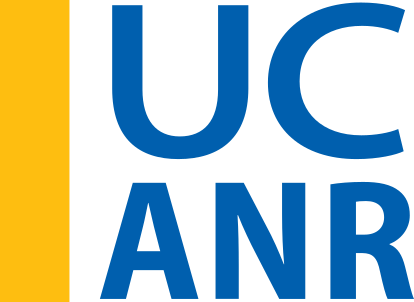- Author: Kathy Keatley Garvey

Hammer, assistant professor of ecology and evolutionary biology, UC Irvine, will give the in-person and virtual seminar, hosted by the UC Davis Department of Entomology and Nematology, at 4:10 p.m. in 122 Briggs Hall. The Zoom link: https://ucdavis.zoom.us/j/99515291076.
Community ecologist Rachel Vannette, associate professor, UC Davis Department of Entomology and Nematology, is hosting the seminar.
"How do insects and microbes form symbioses, and why do these partnerships often break down?" Hammer asks in his abstract. "We are addressing these questions with the gut microbiomes of social corbiculate bees. Despite an ancient association with their bee hosts, these symbionts are surprising dynamic over developmental, ecological and macroevolutionary time scales. I will discuss our recent discoveries of symbiont loss in bees, and efforts to understand why and how these losses occur."
Hammer received his bachelor's degree in general biology from UC San Diego in 2009 and his doctorate in evolutionary biology in 2018 from the University of Colorado, Boulder. He served as a postdoctoral researcher at the University of Texas, Austin, from 2018 to 2021.
Hammer's research interests include microbiomes, symbiosis, microbial ecology and evolution, bees, biodiversity, insect-plant interactions and tropical biology.
"We are a new research group at UC Irvine studying the ecology and evolution of symbioses between hosts (especially bees) and microbes," he writes on his lab website.
Nematologist Shahid Siddique, assistant professor, UC Davis Department of Entomology and Nematology, is coordinating the spring seminars. For Zoom technical issues, contact him at ssiddique@ucdavis.edu.
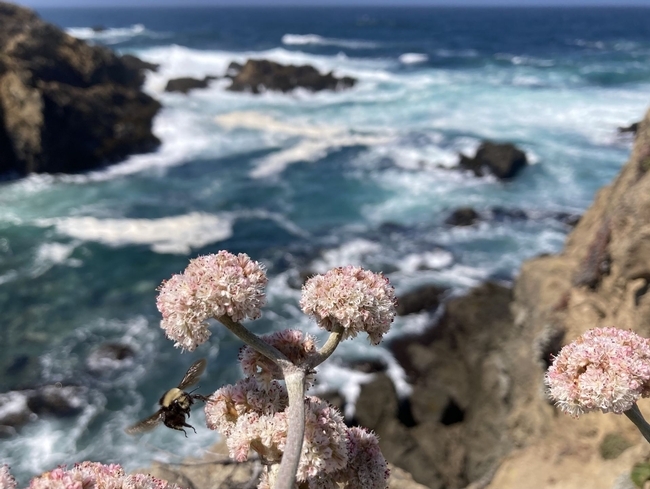
- Author: Kathy Keatley Garvey

The two postdoctoral scholars, Jacob "Jake" Francis and Jacob "Jake" Cecala, have just received prestigious federal research fellowships. And well-deserved!
Francis, a member of the Vannette lab since 2020, received a National Science Foundation (NSF) Postdoctoral Research Fellowship in Biology (PRFB) to study secondary metabolites in nectar and their consequences for microbes and pollinators. His project is titled “Genetic Signal and Ecological Consequences of Toxic Nectar in Plant-Pollinator Microbe Interactions.”
Cecala, who just received his doctorate from UC Riverside, will join the Vannette lab this fall to study the effects of water availability and pesticide use on bees and bee-microbe associations.
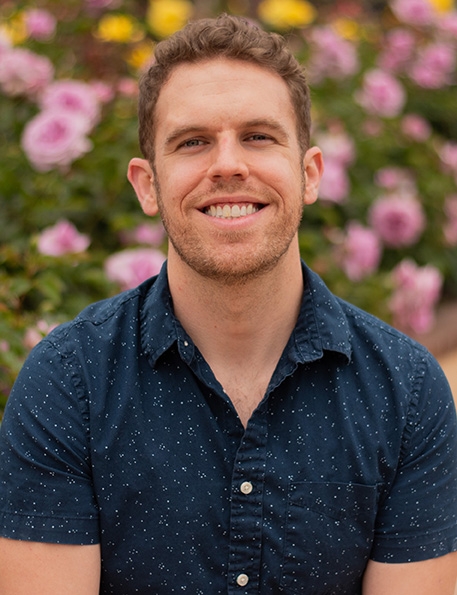
We wrote more about them on the UC Davis Department of Entomology and Nematology website. These are two amazing young scholars and we expect great things from them.
Francis received his doctorate in 2020 from the University of Nevada, Reno, working with advisor Anne Leonard of the Department of Biology's Program in Ecology, Evolution and Conservation Biology. He holds a bachelor's degree from the University of North Carolina Asheville (2011) in ecology and evolution, summa cum laude, with distinction as both a research scholar and an honors scholar.
Cecala, who holds a doctorate in entomology (2021) from UC Riverside, was advised by associate professor Erin Wilson-Rankin (formerly of the Louie Yang lab, UC Davis). His dissertation: “Commercial Plant Nurseries as Habitat for Wild Bees.” He holds a master's degree in biological sciences (2015) from California State Polytechnic University, Pomona, where he completed his thesis, “Bee Visit Frequency and Time of Day Effects on Cumulative Pollen Deposition in Watermelon” with professor Joan Leong, who was a doctoral student of the late Robbin Thorp, UC Davis distinguished emeritus professor. Cecala was awarded his bachelor's degree in biology, summa cum laude, with a minor in French, also from Cal Poly Pomona.
Cecala is also a 2013 graduate of The Bee Course, sponsored by the American Museum of Natural History, held annually at the Southwestern Research Station, Portal, Ariz. Professor Thorp served as one of the longtime instructors; his legacy lives on in the next generation of dedicated bee scientists.
The Vannette lab projects are in full force. Vannette, a former postdoctoral fellow at Stanford University, explains on her website, "the Vannette lab is a team of entomologists, microbiologists, chemical ecologists, and community ecologists trying to understand how microbial communities affect plants and insects (sometimes other organisms. too). We often study microbial communities in flowers, on insects or in soil. We rely on natural history observations, and use techniques from chemical ecology, microbial ecology and community ecology. In some cases, we study applied problems with an immediate application including pathogen control or how to support pollinators. Other questions may not have an immediate application but are nonetheless grounded in theory and will contribute to basic knowledge and conservation (e.g. how can dispersal differences among organisms affect patterns of abundance or biodiversity?)."
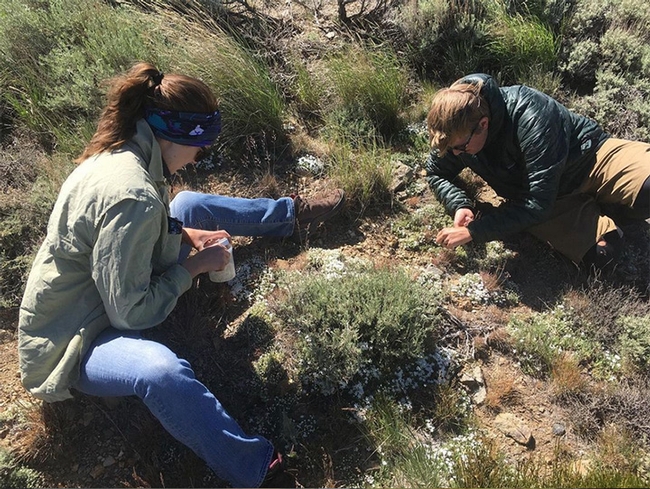
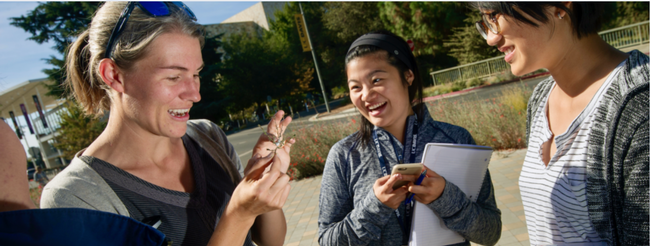
- Author: Kathy Keatley Garvey
If you marked your calendar to attend the Saturday, March 21 open house at the Bohart Museum of Entomology, UC Davis campus, you can unmark it.
For now.
The Bohart Museum of Entomology has postponed its open house to comply with the new UC Davis policies regarding coronavirus pandemic cautions. Officials initially set the open house, themed "Pollinators and Microbes," from 1 to 4 p.m.
In the meantime, head out to your favorite pollinator garden and see what's foraging. You might see not only honey bees, but yellow-faced bumble bees (Bombus vosnesenskii), Gulf Fritillaries (Agraulis vanillae) mourning cloaks (Nymphalis antiopa) and more. Spring begins March 19!
"Studying insects is something you can do anytime or anywhere," Bohart officials said. "We recommend that individuals and families get outside and explore arthropods. Here are great info sheets for many of the common arthropods in a California backyard or a local park.
- Common Insects, Information Sheets (Written by Bohart director Lynn Kimsey, UC Davis professor of entomology.
- How to Collect Insects (Video)
The Bohart Museum, located in Room 1124 of the Academic Surge Building on Crocker Lane, and directed by Lynn Kimsey, UC Davis professor of entomology, houses nearly 8 million insect specimens, a live petting zoo, and a gift shop.
Department Seminars
The UC Davis Department of Entomology and Nematology weekly Wednesday seminars are now virtual seminars and are being live-streamed through Zoom and linked on the department's website, says coordinator Rachel Vannette, community ecologist and assistant professor. (See list of spring seminars)
Plant Sale
The UC Davis Arboretum and Public Garden Plant Sale, initially slated March 14, is also canceled due to the coronavirus outbreak, now global.
For information on the coronavirus, see the Centers for Disease Control and Prevention website.
UC Davis Directives as of March 12 (See website for updates)
From Chancellor Gary May:
Acting out of an abundance of caution amid the coronavirus (COVID-19) outbreak, we have decided to take additional steps in our efforts to protect our students, faculty and staff, and the community at large, as we all do our part to help contain the spread of the virus.
We take these actions in consultation with the UC Office of the President, the Academic Senate and campus administrators, as well as Yolo County Public Health (which, as of today, has reported one confirmed case of COVID-19 in the county, none on the Davis campus). As this situation continues to evolve rapidly, we will respond with further directives. For now, this letter addresses the following topics:
Gatherings — Mandating the cancellation or postponement of events with planned attendance of more than 150 people, from Thursday, March 12, through March 31. We are evaluating this timing on an ongoing basis, as we continue to consult with public health officials. This mandate does not apply to instruction through the end of this week. Our overarching goals: For the sake of everyone's health, we want to minimize face-to-face contact, in instruction and office hours, in workspaces and large gatherings. And we want to emphasize to students, staff and faculty: If you are sick, stay home.
Instruction
As we strive to minimize face-to-face contact, we announced March 7 that faculty and students have maximum flexibility to complete their Winter Quarter work without having in-class instruction. We are now strongly encouraging faculty to go online with their teaching. We said webinars would be available to faculty who needed assistance making the conversion — and we now have a schedule of four different webinars on quizzes/exams and other Canvas tools, and web conferencing and video. Each is being presented daily, every day this week. The schedule and links are here on the Keep Teaching website. It is very likely that we will need to have online capacity in place for Spring Quarter classes.
Faculty also are strongly encouraged to make use of other technologies, such as Zoom and Facetime, to provide opportunities for students to approach them with questions.
Graduate and professional instruction: Given the special nature of graduate and professional instruction, we ask the faculty involved to use their discretion in endeavoring to optimize curricular delivery (as well as graduate advising and mentoring) while remaining mindful of public health advice to observe social distancing to the extent possible. We encourage graduate and professional instructors to utilize opportunities for virtual instruction and testing where appropriate.
See more at https://www.ucdavis.edu/news/coronavirus-new-campus-directives/


- Author: Kathy Keatley Garvey

Have you ever considered them as important vectors of floral microbes?
Well, they are!
Community ecologist Ash Zemenick, formerly in the graduate student program of the UC Davis Department of Entomology and Nematology, will present an exit seminar, "Do Flower Visitors Network with Floral Microbes?" from 4:10 to 5 p.m., Wednesday, Nov. 8 in 122 Briggs Hall, UC Davis campus.
Zemenick received a doctorate in entomology in September 2017 from UC Davis, studying with major professor Jay Rosenheim and with assistant professor Rachel Vannette.
"Flowers are colonized by diverse microbial communities that can influence plant and pollinator health and mediate plant-pollinate interactions," says Zemenick, now a National Science Foundation postdoctoral fellow in the Weber lab at Michigan State University. "Because flower-visiting insects and hummingbirds can harbor high densities of microbial cells, flower visitors are thought to be important vectors of floral microbes. Although floral microbe community assembly is dependent, in part, on dispersal by flower visitors, floral microbe community assembly has yet to be fully considered in the context of the rich network of plant-flower visitor interactions with which they are linked."
The Zemenick dissertation involved "using an historic flower visitor dataset, field experiments and construction of a plant-flower visitor-microbe network to demonstrate the importance of flower visitor identity and interaction in mediating floral microbe community assembly and structure at both local and regional scales."
"With the help of four motivated undergraduates and many gracious entomologists, I built a tripartite plant-flower visitor-floral microbe network. Data was collected from 20 co-flowering plant species over a short phenological timespan in a high elevation wet meadow located in the Tahoe National Forest."
"Questions I (set about) answering with this dataset included: do plants occupy similar positions in both networks? Do plants with similar visitors have similar microbes? Which plants are hubs of floral microbe diversity? Can we determine whether dispersal (by visitor) or environmental filtering (by plant traits) is more important in structuring floral microbial communities?"
As a PhD candidate in the Rosenheim lab, Zemenick worked to "disentangle how the structure of plant-flower visitor interactions varies for different types of flower visitors, and the implications of varying structure for floral microbe communities."
Now, as a post doc in the Weber lab, "I will be studying how plant-mite interactions directly and indirectly influence leaf microbial communities and subsequent invasibility by pathogens. I will also be working on building a repository of introductory biology teaching material that humanizes the field of biology and biologists. It will include how biological research applies to current societal problems and highlight what it is like to be a biologist. The materials will be comprised of examples provided by biologists that self-identify as being part of underrepresented group(s) in STEM (e.g. in terms of race, ethnicity, gender, sex, sexuality, income, nationality, immigrant status, cognitive and physical ability, etc.)."
Overall, Zemenick enjoys studying ecological networks, community assembly, plants, insects, and microbes. "I also love to teach and help students get involved in research."
See more information on Zemenick's website, Inclusive Plant-Insect Microbial Ecology.
The UC Davis Department of Entomology and Nematology's fall quarter seminars, coordinated by Rachel Vannette, assistant professor, are held Wednesdays from 4:10 to 5 p.m. in 122 Briggs Hall. They are open to all interested persons. See seminar schedule.
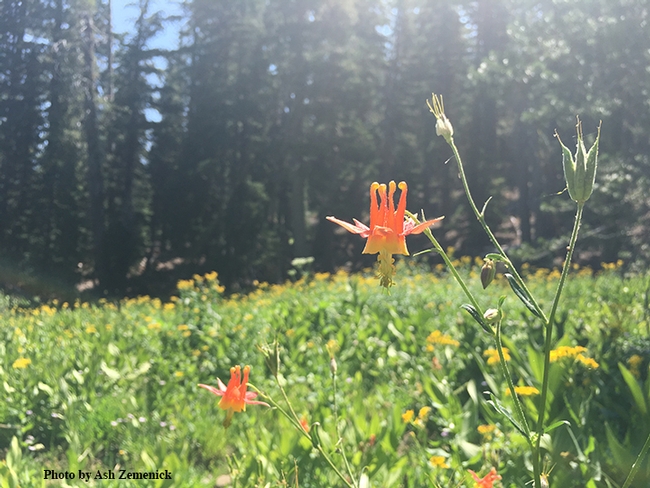

- Author: Kathy Keatley Garvey
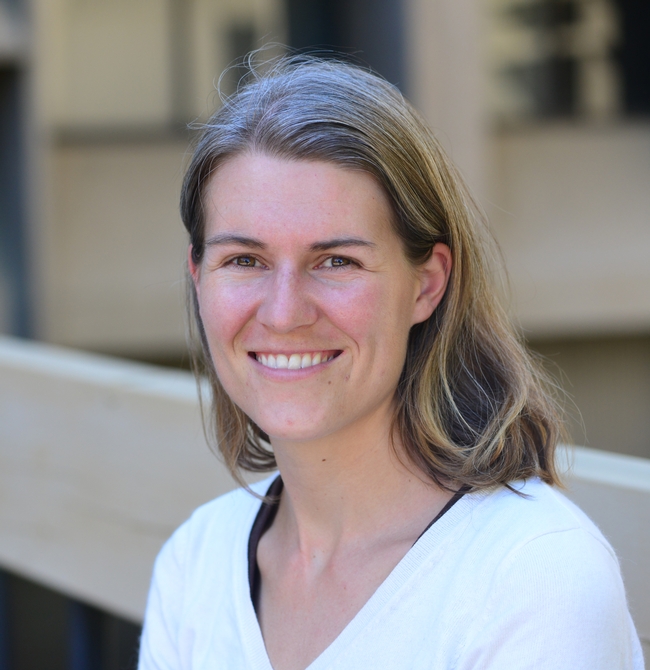
They buzz toward a blossom, sip nectar, and then head for another blossom. Typical, right?
But there's much more going on than you think.
It's not just the nectar that she's scented.
UC Davis community ecologist Rachel Vannette has just published a paper in New Phytologist journal that shows nectar-living microbes release scents or volatile compounds, too, and can influence a pollinator's foraging preference.
The groundbreaking research shows that nectar-inhabiting species of bacteria and fungi “can influence pollinator preference through differential volatile production,” said Vannette, an assistant professor in the UC Davis Department of Entomology and Nematology.
“This extends our understanding of how microbial species can differentially influence plant phenotype and species interactions through a previously overlooked mechanism,” Vannette said. “It's a novel mechanism by which the presence and species composition of the microbiome can influence pollination.”
“Broadly, our results imply that the microbiome can contribute to plant volatile phenotype,” she said. “This has implications for many plant-insect interactions.”
Their paper, titled “Nectar-inhabiting Microorganisms Influence Nectar Volatile Composition and Attractiveness to a Generalist Pollinator,” may explain in part the previous documented extreme variation floral volatiles that Robert Junker of University of Salzburg, Austria, and his team found; New Phytologist published their work in March 2017.
In their study, the Vannette team researchers first examined field flowers for the presence of nectar-inhabiting microbes, and in collaboration with co-authors Caitlin Rering and John Beck of the U.S. Department of Agriculture's Agricultural Research Service (USDA-ARS), Gainesville, Fla, characterized the headspace of four common fungi and bacteria in a nectar analog. Next, they used an intricate setup to quantify the antennal and behavior responses of honey bees to the chemical compounds. Finally, when they examined the scent of flowers in the field, they found that flowers which contained high densities of microorganisms also contained volatile compounds likely produced by those microbes, suggesting that microbial scent production can be detected and used by pollinators.
Although microbes commonly inhabit floral nectar, microbial species differ in volatile profiles, they found. “Honey bees detected most of the microbial volatiles or scents that we tested,” Vannette said, “and they distinguished the solutions of yeasts or bacteria based on volatiles only.” This suggests that pollinators could choose among flowers based on the microbes that inhabit those flowers.
The yeast Metschnikowia reukaufii produced the most distinctive compounds (some shared with the fruity flavors in wine) and was the most attractive of all microbes compared. This yeast is commonly found in flower nectar and is thought to hitch a ride on pollinators to travel from one flower to the next. Its scent production may help it attract pollinators, which then help the yeast disperse among flowers.
The Harry H. Laidlaw Jr. Honey Bee Research Facility, UC Davis, provided the honey bees. More than 20 species of flowers--mostly natives--were used in the survey, including canyon delphinium or canyon larkspur (Delphinium nudicaule), sticky monkey flower (Mimulus aurantiacus), salvia (Lepechinia calycina) and purple Chinese houses (Collinsia heterophylla). The samplings were done in the spring and early summer, when the natives are at their peak.
Co-authors of the paper are Caitlin Rering, postdoctoral fellow at USDA-ARS, Gainesville, Fla.; John Beck researcher at USDA-ARS; Griffin Hall, junior specialist in the Vannette lab; and Mitch McCartney in UC Davis Department of Mechanical and Aerospace Engineering.
The USDA and USDA-ARS funded the research.
About Rachel Vannette: She joined the UC Davis Department of Entomology and Nematology in September of 2015 from Stanford University where she was a postdoctoral fellow.
A native of Hudsonville, Mich., Vannette received her bachelor of science degree in biology with honors at Calvin College, Grand Rapids, Mich., and her doctorate in ecology and evolutionary biology from the University of Michigan, in 2011. Her dissertation was entitled “Whose Phenotype Is It Anyway? The Complex Role of Species Interactions and Resource Availability in Determining the Expression of Plant Defense Phenotype and Community Consequences.”
In her PhD research, she examined how variation in nutrient availability and plant associations with mycorrhizal fungi belowground influenced defense chemistry in milkweed plants and the performance of a specialist herbivore (Danaus plexippus). She found that resource-based tradeoffs can in part explain plant allocation to antiherbivore defense and mycorrhizal fungi. This work also describes that plant genotypes vary in their investment in defense and associations with below ground fungi.
As a Stanford University postdoctoral fellow, funded by a life sciences research fellowship, Vannette examined the community ecology of plant-associated microorganisms. Using diverse systems, she studied the assembly of microbial communities, microbial response to anthropogenic changes like habitat fragmentation, and microbial effects on plant-pollinator interactions.
The National Wildlife Research Foundation featured Vannette's research on monarchs and milkweed in its March 11, 2013 piece on “Catering to Butterfly Royalty." The article, by author Doreen Cubie, focused on Vannette's research as a graduate student at the University of Michigan. Vannette and advisor Mark Hunter studied five common species of milkweeds, the host plant for monarchs. They found that climate change may disrupt the chemistry of milkweeds, and encouraged gardeners to help the monarchs by planting more of these critical host plants.
